Carnival on the Reef
At Wakatobi, it’s easy to get caught up in the show. Remember the excitement when the carnival came to town? The midway envelops you in a blurring parade of festive colors and frenetic activity. Show-stopping beauties steal the limelight, roving bands of juveniles flit in and out of the crowd, and there are plenty of everyone’s favorites: the sideshow freaks. With a little imagination, the reefs of Wakatobi can be transformed into an underwater carnival, complete with a cast of bizarre characters and amazing acts.
The show begins the moment you arrive at the reef, that underwater equivalent of the midway. Marvel at the sights made possible by Wakatobi’s clear waters, and don’t be in a hurry to rush off to the next attraction. Slow down and look closer, because many of the best entertainers are on the small size.
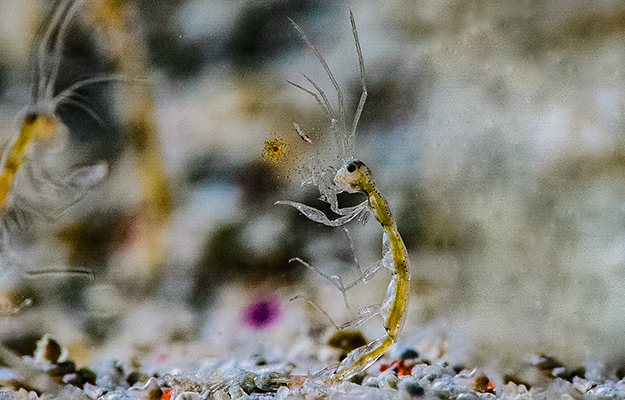
The skeleton shrimp’s fiery temperament makes for some entertaining observation. Photographer Wade Hughes captured this scene at the dive site Teluk Maya as the shrimp appeared to be playing with its food. Photo by Wade Hughes
Tiny dancers
Sometimes it’s the smallest performers that put on the biggest show. This is certainly the case for the skeleton shrimp. You’ll have to look closely to see one of these tiny amphipods clinging to a gorgonian or hydroid and bryozoans, as they are just 1 to 2 cm long and a couple of mm wide. What makes these hungry little guys entertaining is the way they grip with their rear legs as they sway with the current while using their front claws to grab at anything that drifts past. They’ll grab any snack that’s within reach: crustaceans larvae, protozoa, worms, detritus, you name it.
Working the crowd
Like carnival barkers working the crowd, the cleaner wrasses motion to passing fish with their own version of a step right up. And like any good hustler, they are hoping to get something from their marks. But it’s all good because cleaner wrasses feed on the parasitic isopods that cling to fish.

When fish have had enough of irritating parasites that latch on to their body, they become willing clients for the cleaner wrasse’s attention. Photo by Rob Darmanin
Those isopods can become a big irritation as they take nutrients from their host, and when fish have had enough, they become willing clients for the cleaner wrasse’s attention and will hold motionless and allow these small, neon-blue striped fish to move freely over their mouth and gill cavities, nipping and tucking until all is tidy.
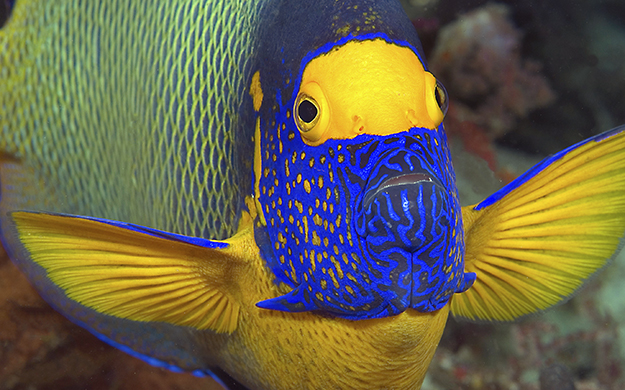
Blueface angelfish inhabit reefs where coral growth is prolific and they are always a welcome sight by divers and snorkelers. The blue coloration contrasting with the yellow between its eyes makes it look like the fish is wearing a blue veil. Photo by Mark Goyen
Getting an eyeful
Any good carnival sideshow will offer some G-rated titillation in the form of an exotic dancer from the East. The striking facial coloration of the Blueface angelfish is certainly reminiscent of the crocheted veils worn by Egyptian Baladi dancers. Outstretched pectoral fins add the illusion of swirling capes as this colorful fish undulates with the current. Though not shy, these performers do seem to prefer the shelter of a coral grotto or a crevice in the face of the reef.
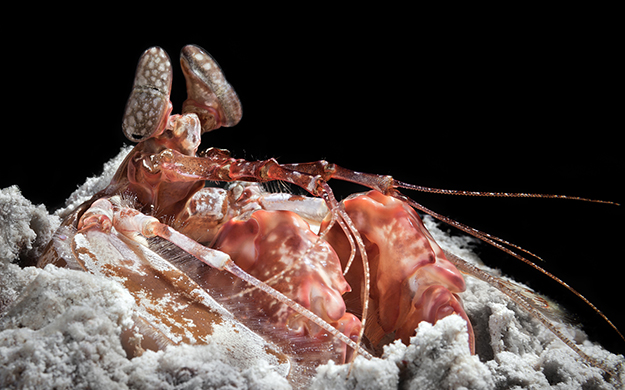
Mantis shrimp are considered to have the best eyesight on earth and they have the most complex eyes in the animal kingdom. Photo by Marco Fierli, marcof8.com
No sideshow venue is complete without its collection of oddities, and the mantis shrimp draws top billing in the world of weird and bizarre. Mantis shrimp are considered to have the best eyesight on earth and have the most complex eyes in the animal kingdom. A unique trinocular vision allows them to perceive both polarized light and multispectral images at the same time, detecting up to 100,000 colors along with 12 color channels, including the ultraviolet range. Just watching a mantis shrimp’s eyes move around independently of each other will leave you wanting more. Because the eyes also move in all directions there’s no sneaking up on this guy.
While on the subject of creepy looking peepers, step into the underwater equivalent of the reptile pit and check out the eyeballs on the crocodilefish. These stealth predators sport a flat, elongated snout and an earth-tone body that serves as camouflage amid sand and rubble bottoms.
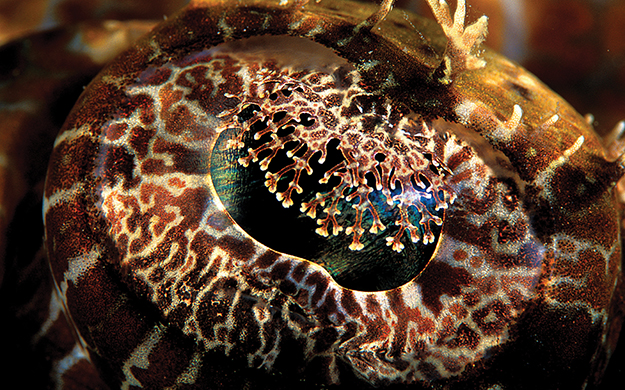
The eyes of the crocodilefish have frilly iris lappets, which help break up the black pupil and improve its concealment. Photo by Wayne MacWilliams
Their camouflage coloration doesn’t end there, the eyes of the crocodilefish have frilly iris lappets, which help break up the black pupil and improve its concealment. Like their reptilian namesake, they are lie-in-wait ambushers, attacking unsuspecting prey with a sudden lunge upwards. Wakatobi is never in short supply when you want to see eye to eye with a crocodilefish. Take a swim around the end of the jetty and you’re likely to spot one.
Hairy creatures
The bearded lady of the reef carnival is the ornate ghost pipefish, as its snout and body sport a covering of short skin filaments that resemble whisker bristles. These enigmatic creatures are a prized find, but much about them remains a mystery. A good place to look for these little wonders is near crinoids, where they will often hover head down amongst the arms. Ghost pipefishes may have some of the best disguises in the sea, which range from uncanny mimicry of leaves, crinoids, algae to sponges and seagrass. Their range of colors and body shapes can surprise and amaze even the most seasoned critter hunter.
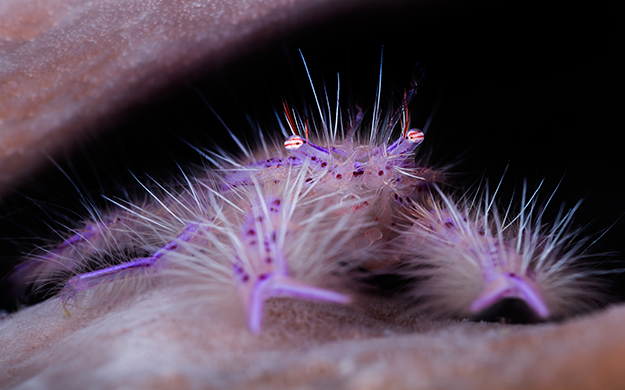
Seeing pink hairy squat lobster up close makes you want to laugh out loud, as it looks like it’s having a very bad hair day! Photo by Marco Fierli, marcof8.com
Speaking of hairy little creatures, there is the pink hairy squat lobster. Seeing one up close makes you want to laugh out loud, as it looks like it’s having a very bad hair day! Not a true lobster, this marine crustacean is also known as the Fairy crab. These creatures are tiny, typically measuring no more than 1.5 cm in length, with a near translucent body and florescent pinkish-purple coloration. The standout feature is squat lobster’s long white hairs, which cover most of its body. To find this particular hairy little fairy, the best place to look is among the convoluted surfaces of the giant barrel sponges which abound on the coral reefs in Wakatobi.


